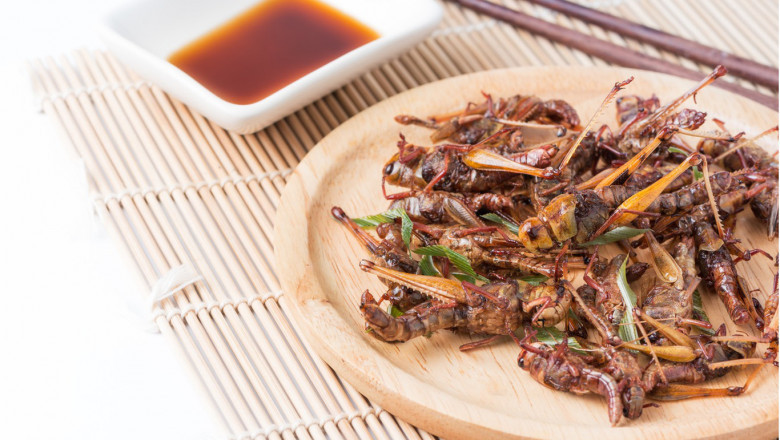views
In the quest for sustainable and innovative food sources, insect protein has emerged as a frontrunner in addressing global nutritional and environmental challenges. Rich in nutrients and requiring minimal resources to produce, insect protein offers a promising alternative to traditional protein sources such as meat, poultry, and fish.
This comprehensive blog delves into the world of insect protein, exploring its nutritional benefits, environmental advantages, market trends, challenges, and its potential to revolutionize the global food system.
What Is Insect Protein?
Insect protein refers to the protein derived from insects, primarily for human consumption or animal feed. Common edible insects include:
- Crickets
- Mealworms
- Grasshoppers
- Black soldier fly larvae
- Silkworms
These insects are typically farmed, harvested, and processed into forms like powders, flours, or whole dried insects.
Nutritional Benefits of Insect Protein
1. High Protein Content
- Insects like crickets and mealworms boast protein levels comparable to beef and chicken.
- Rich in essential amino acids necessary for human health.
2. Packed with Micronutrients
- Iron and Zinc: Essential for immune function and energy.
- Calcium: Important for bone health.
- Vitamin B12: Crucial for nerve function and red blood cell production.
3. Healthy Fats
- Insects contain unsaturated fats, including omega-3 and omega-6 fatty acids.
4. Low in Carbohydrates
- Ideal for low-carb and ketogenic diets.
5. Rich in Fiber
- The exoskeletons of insects, composed of chitin, provide dietary fiber.
Environmental Advantages of Insect Protein
1. Reduced Greenhouse Gas Emissions
- Insect farming emits significantly fewer greenhouse gases compared to livestock farming.
2. Minimal Land and Water Use
- Insects require much less land and water to produce the same amount of protein as cattle or poultry.
3. High Feed Conversion Efficiency
- Insects convert feed into protein more efficiently than traditional livestock.
4. Utilization of Food Waste
- Many insects, like black soldier fly larvae, can be fed on organic waste, reducing food waste and promoting a circular economy.
Applications of Insect Protein
1. Human Consumption
- Protein Powders and Bars: Popular among fitness enthusiasts.
- Flour and Pasta: Used as a sustainable ingredient in baked goods.
- Snacks: Dried insects are marketed as crunchy, savory snacks.
2. Animal Feed
- Aquaculture: Insect meal is used as fish feed.
- Pet Food: Insects serve as a protein-rich alternative in pet diets.
- Livestock Feed: Insect protein supplements for poultry and pigs.
3. Fertilizer
- Byproducts of insect farming can be repurposed as organic fertilizers.
Market Trends in Insect Protein
1. Growing Demand for Sustainable Food
- Rising awareness of climate change and environmental conservation boosts demand for alternative proteins.
2. Increased Investment
- Startups in insect farming have attracted significant funding from venture capital firms.
3. Regulatory Support
- Countries like the EU, US, and Canada have begun approving insect-based products for human consumption.
4. Diversification of Products
- Companies are expanding their product portfolios, introducing insect-based burgers, pasta, and protein shakes.
Key Players in the Insect Protein Market
-
Protix (Netherlands)
- Focuses on black soldier fly larvae for animal feed.
-
Ÿnsect (France)
- Produces mealworm-based protein for human and animal consumption.
-
Entomo Farms (Canada)
- Specializes in cricket protein powders and snacks.
-
Aspire Food Group (USA)
- Develops insect-based food products with a focus on sustainability.
-
AgriProtein (South Africa)
- Produces insect protein for aquaculture and livestock feed.
Challenges Facing the Insect Protein Industry
1. Consumer Acceptance
- The "ick factor" remains a barrier for many consumers unfamiliar with eating insects.
2. Regulatory Hurdles
- Inconsistent regulations across regions slow the global adoption of insect protein.
3. Scalability
- Scaling insect farming operations while maintaining quality is challenging.
4. Cost Competitiveness
- High initial investment and production costs make insect protein more expensive than traditional options.
The Cultural and Historical Context
Eating insects is not new—it has been a part of traditional diets in many cultures for centuries, particularly in Asia, Africa, and Latin America. However, the practice has only recently gained traction in Western markets due to growing environmental awareness.
Future Prospects of Insect Protein
1. Integration into Mainstream Diets
- Improved marketing and product innovation can help normalize insect-based foods.
2. Technological Advancements
- Automation and genetic optimization could enhance production efficiency.
3. Expansion into Emerging Markets
- As awareness grows, insect protein can address nutritional deficiencies in developing regions.
4. Collaboration with Food Giants
- Partnerships with established food brands can accelerate market penetration.
Source: https://www.databridgemarketresearch.com/reports/global-insect-protein-market
Conclusion
Insect protein represents a paradigm shift in how we think about sustainable nutrition. With its immense environmental and nutritional benefits, it holds the potential to address global food security challenges while reducing the ecological footprint of traditional protein sources.
Though challenges remain, innovation, education, and regulatory support are paving the way for insect protein to become a staple in both human diets and animal feeds. As the world moves toward sustainable living, embracing insect protein may be one of the keys to a healthier planet and population.






















Comments
0 comment